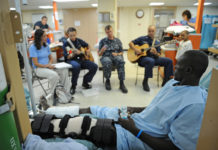In order to support students recovering from substance use disorders, the Health and Counseling Center at the University of Denver recently announced the launch of a Collegiate Recovery Community (CRC). The program, which also aims to prevent relapses and promote academic performance, officially starts today.
Dylan Dunn, the coordinator of the CRC at the University of Denver, highlighted that the establishment of the CRC was prompted by a student’s overdose death last year.
“That [death] was kind of the impetus for the kind of conversations that were happening with collegiate recovery being a field that was growing slowly at first and started to grow really quickly,” he said.
Collegiate Recovery Programs (CRPs) also offer university students an outlet for recovery resources. While the terms CRPs and CRCs are interchangeable, their implementation may vary among academic institutions. For example, a CRP may represent an umbrella entity, under which a CRC may act as a recovery community on campus.
The Association of Recovery in Higher Education (ARHE) certifies CRPs and CRCs throughout the U.S. The ARHE provides the resources, education and connections to help students progress through recovery.
CRPs are similar to Recovery High Schools (RHSs) but have a more advanced model, giving students more flexibility and power to decide how they approach addiction recovery.
“I think college in general just provides a different experience for students,” Dunn said. “Of course, RHS students come in for various reasons; either the criminal justice system has referred them or they found themselves in a situation where parents saw it was the best fit, we even saw students who were there that wanted to be there making the move for themselves in RHS.”

The very first CRP was established in 1977 at Brown University. The model was followed by the Alcohol and Other Drug Assistance Program at Rutgers University and multiple other CRPs, including the Center for the Study of Addictions at Texas Tech University.
According to the ARHE, there are a few important factors that determine whether a CRP will benefit a university and correlate with its mission. Some considerations include whether the CRP will provide substance abuse or mental health services and if a 12-step model or any other counseling services will supplement treatment. CRP administrators will determine what kind of protocols students must follow and the nature of the program — residential, support-based, treatment-based or student organized.
The ARHE outlines several standards to ensure that CRPs and CRCs are efficiently operated.
The programs should promote abstinence-based recovery and include methods of intervention. CRPs are usually nonprofit and aim to contribute an educational model, rather than a business strategy.
CRPs and CRCs also provide a variety of different services — which can include case management services and team building activities — to help students with substance use disorders.
A 2016 report from the University of Maryland’s School of Public Health detailed the academic performance of students in Texas Tech University’s CRC. The report highlighted that 70 percent of CRC students graduated from the university compared with 60 percent of the general population. The average GPA of CRC students was 3.18 GPA while the general population had a mean GPA of 2.93.
“We find that these recovery students actually excel as long as they have a CRP because they already have a discipline,” he added. “They already have a sense of purpose. They just have to be connected with the university in a way that makes sense for them and is compatible with their recovery.”
Some CRPs offer substance-free housing. For example, Rutgers University implemented recovery housing in 1998 after students clamored to have a designated space to stay while recovering from substance use disorders.
Select CRPs expect students to adhered to behavioral and sobriety contracts. Some contract requirements include attending 12-step meetings, avoiding high-risk environments and maintaining educational responsibilities.
The Substance Abuse and Mental Health Services Administration (SAMHSA) published a Behavioral Health Among College Students Information and Resource Kit in 2017 featuring studies that examine the effects of drug abuse among college students.
One of the studies was on alcohol consummation among the 18 to 22 age group — 58 percent of the students reported alcohol use and 37.9 percent said they partook in binge drinking. Of those surveyed, 12.5 percent said that they were heavy drinkers. The study also highlighted that full-time college students were more likely to drink heavily or binge drink than people of the same age who did not attend college or attended on a part-time basis.
“Students at Denver University drink and drug at a rate that is higher than the national average,” Dunn said. “I was brought in, my goal was just having a CRC, having a CRC and a CRP says a lot and it shows the university is willing to say ‘yes we acknowledge that collegiate culture is recovery hostile and we’re not going to use the stigma as a reason to shy away from saying we have students in recovery’.”
SAMHSA’s outlines that in 2015 14.6 percent of full-time college students were diagnosed with a substance use disorder while 11.2 percent had an alcohol use disorder.

The 2014 National Survey on Drug Use and Health revealed that 20.2 percent of full-time college students in the 18 to 22 age range reported having a mental illness in the past year.
“We acknowledge at Denver University, and at all the CRCs I’m aware of, that recovery is not a standalone issue in people’s lives but that it’s always intertwined with something else,” Dunn said.
He highlighted that CRCs are greatly focused on addressing all of the elements that have led students to develop a substance use disorder.
CRCs and CRPs are only at 5 percent of the universities in the U.S., Dunn added.
“Nationally, I just want to CRCs at more universities so we can shift that collegiate culture,” he said. “It is scary to think that there are so many students around the country that need this but may not have it within hundreds of miles.”
Dunn would advise students needing help to believe that they are worthy of obtaining assistance for their substance use disorders.
“It’s about feeling that if someone offers me a hand that I am worthy of grabbing onto it,” he said. “There are people all around these students who love and want to help them but it’s so easy to just see the hands that are closed and the people that are judgmental and to feel that stigma that is so real even though there are people around you who want to help fight that stigma and really want to help you get out of the dark times.”















